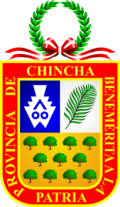Chincha Alta | |
|---|---|
Town | |
| Nickname: "Cuna de campeones" (Cradle of Champions) | |
| Coordinates: 13°27′S76°08′W / 13.450°S 76.133°W | |
| Country | |
| Region | Ica |
| Province | Chincha |
| Government | |
| • Mayor | Armando Huamán Tasayco |
| Area | |
• Total | 2,988 km2 (1,154 sq mi) |
| Elevation | 97 m (318 ft) |
| Population | |
| 177,219 | |
| Demonym | Chinchano/a |
| Time zone | UTC-5 (PET) |
| • Summer (DST) | UTC-5 (PET) |
| Website | www.munichincha.gob.pe |

Chincha Alta, also known as simply Chincha, is a city located in the Ica Region of Peru. A major port at the mouth of the Chincha River, it is the capital of Chincha Province. The city has a population of about 233,000, making it the 17th largest city in Peru.










